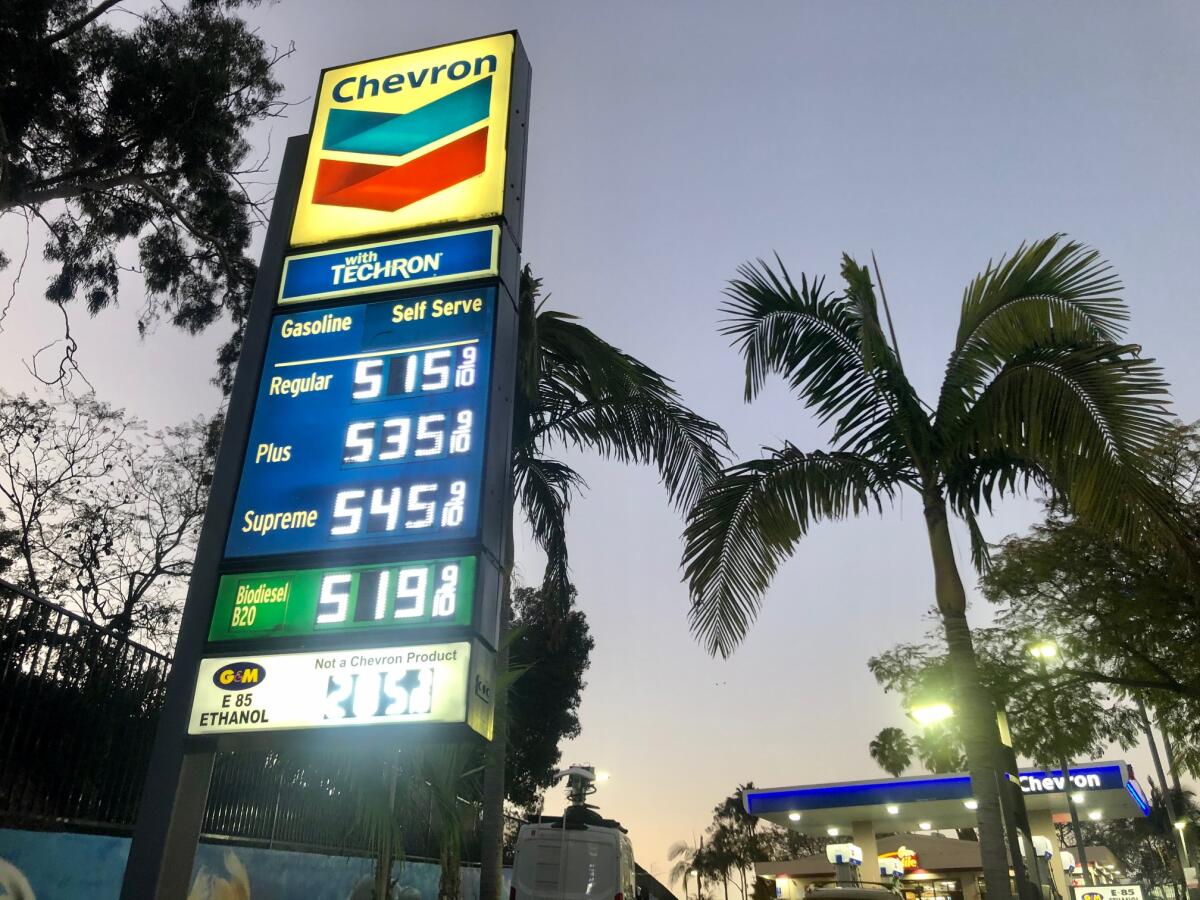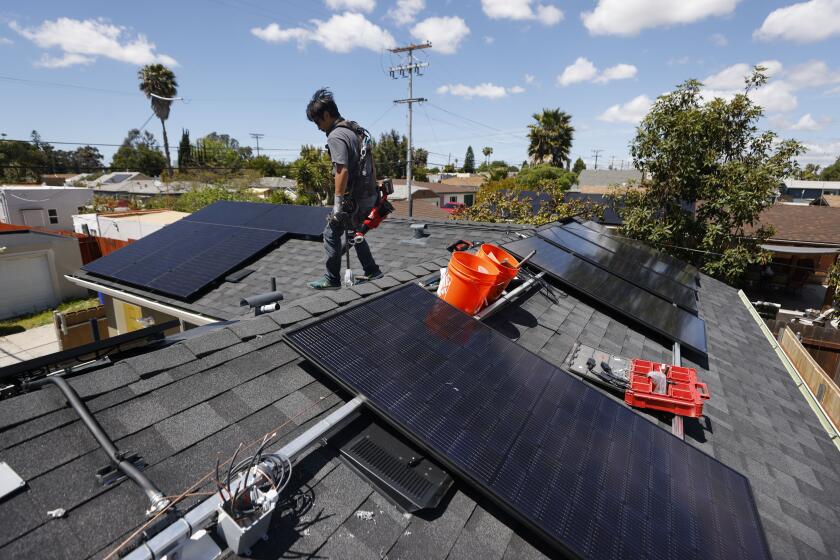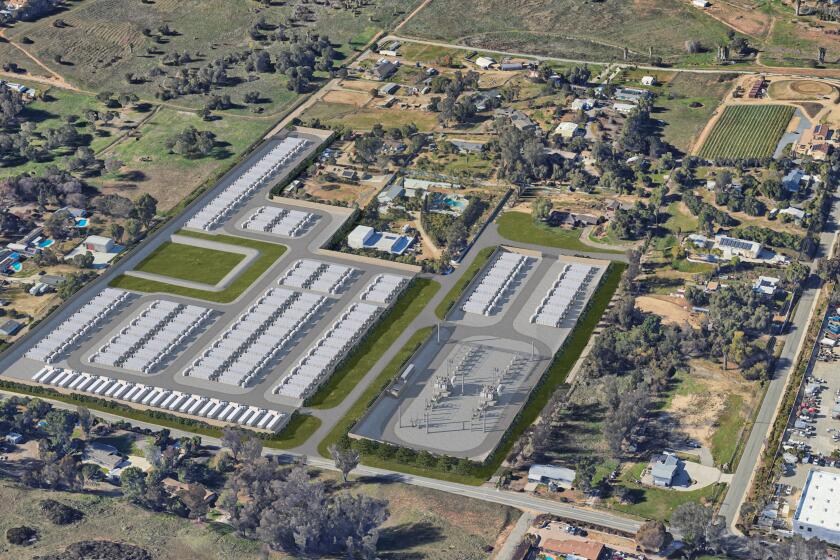San Diego hurtles toward $5-a-gallon gasoline

War in Ukraine leads to the latest price spike; GasBuddy analyst predicts $5.50 “in the next month or two.”
Rising gasoline prices have shifted into overdrive after Russia’s invasion of Ukraine led to a surge in crude oil prices, with stations in the San Diego area Wednesday posting an average of $4.88 for regular-grade gas. That’s an increase of 13 cents in the past week.
“Five dollars a gallon is in sight,” said David Hackett, president of Stillwater Associates, a transportation energy consulting company in Irvine.
This story is for subscribers
We offer subscribers exclusive access to our best journalism.
Thank you for your support.
Russia is the world’s third-largest producer of crude oil, accounting for about 12 percent of global supplies. Crude oil prices steadily rose prior to Vladimir Putin’s assault on Ukraine and then surged after the invasion began on Feb. 24.
The price of West Texas Intermediate — the benchmark price for U.S. crude — ballooned 8.1 percent in a single day Tuesday and kept rising after markets opened Wednesday. WTI finished the trading day up another 7.7 percent to $111.40 a barrel. That’s the highest price in nearly eight years, when the benchmark price hit $104 in July 2014.
“We’re past that now,” Hackett said. “We’re heading into new territory.”
Oil is a global commodity and the price of gasoline is tied to the price of crude. About 60 percent of Russian oil typically goes to Europe, with about 20 percent heading to China. A small amount even ends up in California refineries.
Using data from the U.S. Energy Information Administration, Hackett said 17.6 million barrels of Russian crude made it to the Golden State in 2021. That works out to about 48,000 barrels a day, or about 3 percent of the state’s oil imports.
About half of all the oil supplying California refineries comes from foreign countries, such as Saudi Arabia.
“Any threat to supply from Russia is a threat to the total world (oil) supply, which will tend to drive prices up,” Hackett said.
The price of Brent crude futures — the international benchmark — has also taken off since the invasion of Ukraine. It traded Wednesday at $115.01 a barrel.
The latest spike in gasoline prices comes just two weeks after the San Diego region broke its previous record of just over $4.72 per gallon. In the past month, the average price for regular has gone up 24 cents per gallon, according to GasBuddy, a company that helps drivers find the cheapest gas in their area. Compared to one year ago, prices are up $1.15.
“Five dollars a gallon is probably less than a week away,” said Patrick De Haan, GasBuddy’s head of petroleum analysis, noting that wholesale gas prices in Los Angeles shot up 26 cents on Wednesday. “It could maybe go to $5.25 in the next two to three weeks and maybe $5.50 in the next month or two.”
In addition to the Ukraine crisis, DeHaan said prices in California are on the rise because stations recently started transitioning from winter- to summer-blended fuel, which is more expensive.
DeHaan offered an unusual suggestion to give motorists some financial relief — temporarily suspend the switch to the summer blend by having California issue a waiver concerning Reid Vapor Pressure, or RVP, which measures the volatility of gasoline. DeHaan estimated defaulting to winter gas could knock the price down by about 20 to 40 cents per gallon.
“Now there are repercussions,” DeHaan said. “Keep in mind that this fuel is more volatile during warmer months. It generally contains more butane, which is a higher emitting component, so there are downsides and it’s definitely not a perfect plan. There are costs but I think the economic effect could be significant.”
A spokesman for the California Air Resources Board said seeking such a variance would be part of a legal process that would entail going through an administrative hearing. That, “coupled with the fact that refiners are already in the process of producing summer fuel and would have to retool, would make the idea of a variance seem impractical,” the spokesman said in an email.
Gov. Gavin Newsom in January proposed suspending the automatic rise in the state’s gasoline excise tax that is tied to inflation. It’s estimated the change would save $523 million for motorists and the state’s $45.7 billion budget surplus would be applied to make up for the lost revenue.
But last month, Senate President Pro Tem Toni Atkins, D-San Diego, and Assembly Speaker Anthony Rendon, D-Lakewood, did not express support for the idea. “If we’re going to halt the gas tax, we want to make sure that we have a sense of what that means to our state and to our economy,” Rendon told the Sacramento Press Club.
Assemblymember Kevin Kiley, R-Rocklin, has introduced legislation to suspend the entire excise tax for six months, which would translate to just over 50 cents per gallon.
Nationally, President Joe Biden announced at Tuesday’s State of the Union address that the U.S. will release 30 million barrels of oil from the Strategic Petroleum Reserve. It’s part of a 60-million barrel effort announced by the International Energy Agency’s 31 member countries to help make sure that supplies won’t fall short in the wake of Russia’s invasion.
But a number of financial analysts doubt the release will have much impact, considering the U.S. consumes a little more than 18 million barrels of petroleum per day and the 60 million-barrel figure accounts for less than one day of worldwide consumption.
“Crude prices can’t stop going higher as a very tight oil market will likely see further risk to supplies as the war in Ukraine unfolds,” Edward Moya, senior market analyst with foreign currency company Oanda, said in a note to investors.
The all-time high price for U.S. domestic crude is $147 a barrel, set in July 2008.
Republicans have criticized the Biden administration’s energy policies, such as the president’s decision on his first day in office to revoke the cross-border permit for the Keystone XL pipeline that was poised to send about 800,000 barrels of oil a day from Canada to the Texas Gulf Coast. But Energy Secretary Jennifer Granholm this week emphasized investing in renewable energy sources to reduce dependence on Russian oil and gas.
Nationally, the average price for regular Wednesday stood at $3.68 per gallon, up 25.3 cents from one month ago, according to GasBuddy.
What would it take for prices to drop?
“A nuclear deal with Iran, Russia signing a peace treaty and completely exiting Ukraine, Putin getting canned in some way, shape or form,” DeHaan said.
U.S. officials have been negotiating to revive the controversial 2015 Iran nuclear deal, which would include lifting sanctions on oil imports from the Islamic Republic.
“Russia and Iran, if both of those went our way,” DeHaan said, “I think the summertime average (in the U.S.) could fall to $3.25 to $3.50 a gallon instead of very likely $4 to $4.25 a gallon.”
Get U-T Business in your inbox on Mondays
Get ready for your week with the week’s top business stories from San Diego and California, in your inbox Monday mornings.
You may occasionally receive promotional content from the San Diego Union-Tribune.










